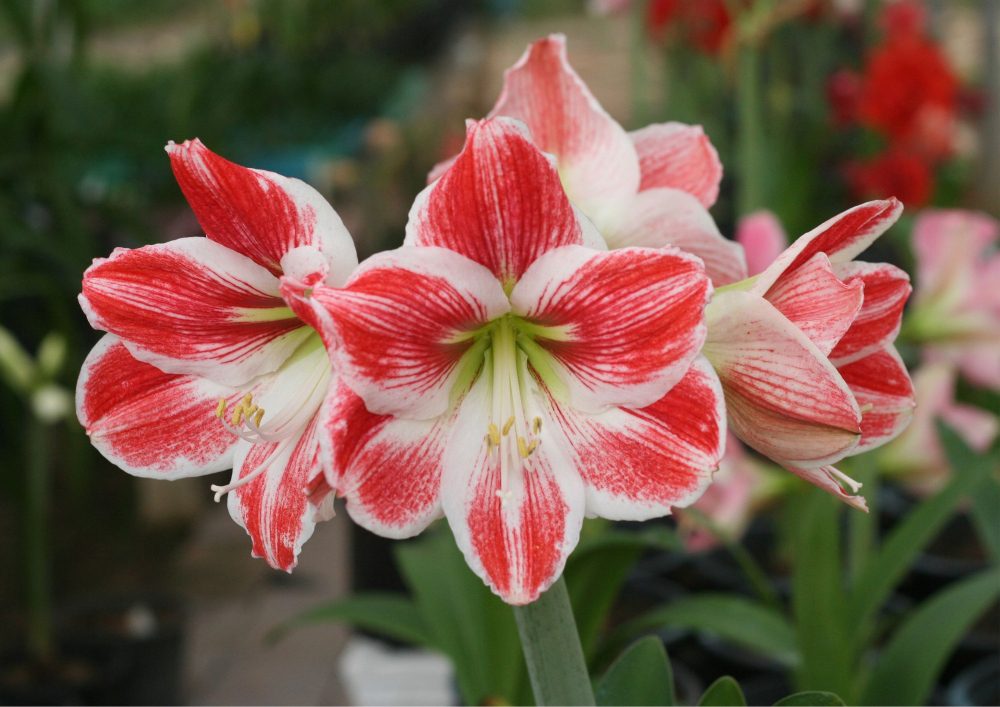
In the world of flowering bulbs, few captivate the heart and soul quite like the majestic Amaryllis. With its vibrant, trumpet-shaped blooms and elegant presence, the Amaryllis stands as a symbol of beauty and resilience. If you share an interest in cultivating these exquisite flowers in your garden, let this guide serve as your companion on the path to mastering the art of growing and nurturing them.
Exploring Amaryllis
Contents
The Amaryllis, scientifically known as Hippeastrum, is a genus of bulbous flowering plants native to South America. Renowned for its large, showy flowers, Amaryllis has become a favourite choice for both indoor and outdoor cultivation. These blooms, available in a spectrum of colors and shapes, bring a touch of elegance to any garden or living space.
Understanding Amaryllis Varieties
Amaryllis offers a diverse array of varieties, each possessing its own unique charm. From the classic red Amaryllis to hybrids in shades of pink, white, and even bi-coloured blooms, enthusiasts can curate a garden that reflects their personal aesthetic preferences.
These variations in colour not only add visual interest but also enable the creation of harmonious arrangements or bold contrasts, turning your Amaryllis garden into a personalized masterpiece that evolves with the seasons.
Amaryllis Symbolism
Beyond their visual appeal, Amaryllis blooms carry symbolic significance. In various cultures, these flowers are associated with traits such as love, beauty, and determination. Understanding the symbolism adds a layer of depth and meaning to your Amaryllis garden.
This exploration transforms your garden into a living canvas, where each petal and stem carries whispers of tradition, emotion, and the timeless allure of nature’s poetry.
Planting Amaryllis Bulbs
The journey of Amaryllis begins with the careful selection and planting of bulbs. Ensuring the right conditions from the start sets the stage for healthy growth and spectacular blooms.

Selecting Healthy Bulbs
When choosing Amaryllis bulbs, look for firm, plump specimens. Avoid any signs of decay or damage. Larger bulbs often yield more robust flowers, contributing to a more striking display.
Opt for bulbs that showcase vitality and integrity, as they are more likely to yield robust flowers. Embrace the larger bulbs for their increased energy reserves.
Investing in the health and quality of your Amaryllis bulbs during the selection process is a proactive step towards ensuring a flourishing and vibrant garden showcase.
Planting Depth and Timing
Plant Amaryllis bulbs with about one-third of the bulb above the soil line. Timing is vital – the fall and early winter months are optimal for planting, allowing the bulbs to establish roots before the blooming season.
As the natural rhythm of the seasons transitions from the warmth of summer to the cool embrace of autumn, the fall and early winter months offer a climate that is conducive to successful Amaryllis bulb planting.
During this period, the soil retains residual warmth from the fading summer, creating an environment that is welcoming and supportive of initial root development. Simultaneously, the ambient temperatures are moderate, striking an ideal balance that encourages the bulbs to acclimate seamlessly to their new surroundings.

The strategic choice of planting during the fall and early winter affords Amaryllis bulbs an extended period to establish a strong and resilient root network. This vital phase not only anchors the bulbs securely in the soil but also lays the groundwork for efficient nutrient absorption, promoting overall plant health.
By aligning the planting process with the natural growth cycle of Amaryllis bulbs, this timing ensures a synchronized progression of their developmental stages with the changing seasons. This synchronization sets the stage for a more harmonious and vigorous blooming period when the plants reach maturity.
Soil and Pot Selection
Amaryllis thrives in a well-draining potting mix. Opt for containers with drainage holes to prevent waterlogging. Choosing the right soil and pot ensures the bulb receives the proper nutrients and aeration for successful growth.
Yet, the significance extends beyond nutrient provision. Soil structure becomes a silent architect of growth, with the imperative need for a well-draining medium. Aeration, facilitated by proper soil structure, ensures that the bulb’s roots receive not only the nourishment they crave but also the oxygen essential for metabolic processes.
This dual functionality guards against the perils of waterlogging, a condition that could stunt growth and expose the bulb to various ailments.
Nurturing Growth
Once the bulbs are in place, proper care is essential for nurturing healthy growth. From providing the right amount of sunlight to maintaining a watering and fertilizing routine, here’s how to ensure your Amaryllis thrives.

Sunlight Requirements
Amaryllis favours bright, indirect light. Place your plants in a location where they receive at least six hours of sunlight daily. Rotate the pot periodically to promote even growth and prevent leaning.
By regularly rotating the pot, the plant is compelled to distribute its growth evenly, preventing a unilateral affinity for sunlight that might result in a lopsided or imbalanced form.
Additionally, pot rotation combats the gravitational pull that can subtly coerce the plant to incline in a particular direction. This gravitational responsiveness is particularly pronounced in tall or vining plants, where constant exposure to a unidirectional force may induce a pronounced tilt or curvature.
Watering Tips
While Amaryllis appreciates moist soil, overwatering can be detrimental. Allow the top inch of soil to dry between waterings. Use room-temperature water, and ensure proper drainage to prevent root rot.
The avoidance of extreme temperature fluctuations is paramount, as sudden shifts can stress the plant’s sensitive root system, potentially compromising its ability to absorb nutrients and water optimally. By opting for water at room temperature, we engage in a harmonious exchange with the plant, facilitating a seamless transition from irrigation to absorption, and promoting physiological equilibrium.
Fertilizing Routine
During the growing season, feed your Amaryllis with a balanced liquid fertilizer every 2-4 weeks. Dilute the fertilizer to half the recommended strength. Cease fertilization after the blooming season to allow the plant to enter a period of dormancy.
Ceasing fertilization at this juncture aligns with the plant’s intrinsic rhythm, acknowledging the shifting demands on its energy resources. By withholding additional nutrients, the plant is gently guided into a state of dormancy, where metabolic activity slows down, and growth takes a back seat.

The Dance of Blooms
As the buds unfurl into magnificent blooms, the true magic of Amaryllis unfolds. Understanding the different types of blooms and how to extend the blooming period enhances the overall gardening experience.
Extending the Blooming Period
With proper care and strategic practices, you can extend the blooming period of your Amaryllis. Promptly snip off spent flowers to redirect energy towards new buds. Consider staggered planting or different varieties with varying blooming times for a continuous floral display.
Opt for Amaryllis varieties with distinct bloom times. Deliberately curating a collection that includes early, mid, and late-blooming varieties guarantees a dynamic and evolving floral panorama throughout the growing season. This intentional diversity not only extends the overall blooming period but also enriches the visual tapestry of the garden.
Early Bloomers (Late Fall to Early Winter)
“Red Lion” bursts forth with its rich red blossoms, signalling the commencement of the blooming season with a bold and festive statement.
“Minerva” graces the garden with its red and white striped petals, setting a festive tone during the early winter months.
Mid-Season Blooms (Late Winter to Early Spring)
“Pink Surprise” takes centre stage, unveiling its delicate pink petals that complement the earlier vibrant red, creating a captivating mid-winter display.
“Orange Sovereign” emerges with its vibrant orange blooms, seamlessly transitioning the garden into a mid-winter spectacle of warm and lively hues.
Late Bloomers (Spring to Early Summer)
“White Christmas” unfurls its pristine white blooms, ensuring a serene and elegant end to the Amaryllis showcase as spring unfolds into early summer.
“Dancing Queen” takes the stage with its unique fringed petals, adding a touch of whimsy and ensuring a graceful continuation of the floral panorama into the early summer months.
These intentionally curated collections showcase how the combination of early, mid, and late-blooming Amaryllis varieties ensures a dynamic and evolving floral view, creating a visually captivating and harmonious display throughout the growing season.
A Symphony of Colors

Understanding Amaryllis Colors
Delve into the kaleidoscope of hues, from the classic reds that command attention to the subtle pastels that exude sophistication. Each colour carries its own significance, allowing you to create a garden that reflects your personal style and emotions.
Each colour, with its unique symbolic significance, serves as a vivid brushstroke, contributing to the emotional and aesthetic narrative of your garden. This intentional selection of colours empowers you to curate a garden that not only delights the eyes but also becomes a canvas for expressing the depth and nuances of your individuality.
Designing With Amaryllis Colors
Understanding colour theory enables you to design a harmonious and visually appealing Amaryllis garden. Experiment with colour combinations, consider the surrounding environment and let your creativity flourish as you compose a garden that is both vibrant and aesthetically pleasing.
Harmonious Symphonies
Explore harmonious color schemes, where tones seamlessly blend and complement one another. Consider analogous colour combinations for a serene and cohesive ambience, creating a visual flow that harmonizes the garden’s diverse elements.
Dramatic Contrasts
Embrace the drama of contrasting colours to infuse energy and visual intrigue. Play with complementary hues, pairing opposites on the colour wheel, to create dynamic focal points that captivate the eye and add a touch of excitement to your garden.
Caring for Amaryllis After Blooming
As the bloom cycle reaches its peak, your role as a caretaker evolves. Learn the post-blooming care essentials to ensure the longevity and health of your Amaryllis.
Snipping Off Spent Flowers
Once the flowers have faded, promptly snip off them to redirect the plant’s energy towards new growth. Use clean, sharp scissors to snip off the spent flowers just above the bulb.
By removing spent flowers just above the bulb, you facilitate a seamless redirection of the plant’s energy. This redirection is a botanical strategy, channelling nutrients away from seed production toward the cultivation of new growth, fostering a cycle of continuous renewal.
Allowing Dormancy
After the blooming season, there will be a period of dormancy. Gradually reduce watering and stop fertilizing. Place the plant in a cool, dark location for 8-10 weeks to allow it to rest and recharge.
During this strategic period of seclusion, the absence of light prompts a natural dormancy, allowing the plant to divert its energy inward, fortifying its reserves for the vibrant growth that will follow.
Encouraging Rebloom
To encourage rebloom, reintroduce it to a well-lit area after the dormancy period. Resume regular watering, and you may be rewarded with a new cycle of blooms.
The provision of water serves as a catalyst, awakening the plant from its restful state and reinvigorating its metabolic processes. It prompts the emergence of fresh shoots, leaves, and, with a bit of luck, the initiation of a new flowering cycle. This stage is a testament to the resilience and adaptive nature of your plant, responding to your attentive care with a burst of renewed vitality.

The Wrap Up
There go the various aspects of the Amaryllis growing journey, from selecting the right soil and pot to ensuring proper nutrients and aeration for successful growth. The importance of using room-temperature water and maintaining proper drainage to prevent root rot is also emphasized.
Additionally, periodic rotation of the pot is advised to promote even growth and prevent leaning. There should be a cessation of fertilization after the blooming season to allow the plant to enter a period of dormancy.
Also, remember that the intentional selection of Amaryllis varieties with distinct bloom times extends the flowering period and enriches the garden’s visual tapestry. The use of clean, sharp scissors to snip off spent flowers just above the bulb is highlighted for meticulous care.
There should also be a period of rest and rejuvenation in a cool, dark location, followed by the resumption of regular watering, anticipating the potential reward of a new cycle of blooms.
Overall, you are provided with a holistic approach to Amaryllis care, offering a valuable resource for cultivating these stunning flowers successfully.
Frequently Asked Questions
1. What distinguishes the Amaryllis from other flowering plants?
The Amaryllis plant offers versatility. Because of its massive, stunning blooms and ease of care, amaryllis has become a popular choice for both indoor and outdoor gardening.
2. Why should the Amaryllis plant container be rotated on a regular basis?
By rotating the pot on a regular basis, the plant is forced to disperse its development evenly, preventing a unilateral preference for sunlight that could result in a lopsided or imbalanced form.
3. Why must you cut off spent flowers?
By removing wasted flowers directly above the bulb, you enable a smooth redirection of the plant’s energy. This is a botanical approach that redirects nutrients away from seed formation and toward the establishment of new growth, encouraging a cycle of perpetual renewal.








